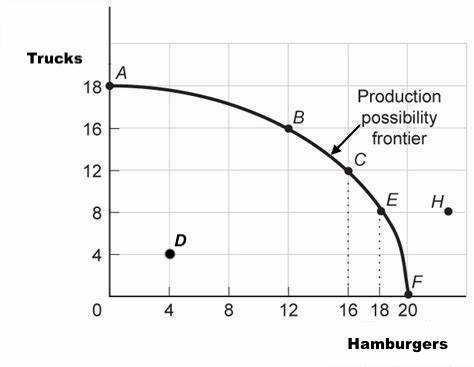
Chapter 5: Basic Economic Concepts
5.1 Scarcity
Scarcity: occurs because unlimited desire for goods and services exceeds limited ability to produce them due to constraints on time and resources
Resources
Also sometimes called inputs or factors of production
Examples
Capital (physical capital): manufactured goods that can be used in the production process
Ex) Tools, machinery, equipment
Labor: physical and mental effort of people
Includes human capital: knowledge and skill acquired through training and experience
Entrepreneurship: ability to identify opportunities and organize production, and willingness to accept risk to pursue rewards
Natural resources: refers to any productive resource existing in nature
Ex) Wild plants, wind, water
Acronym: Crazy Leopards Envy Narwhals → Capital, Labor, Entrepreneurship, Natural resources/land
Energy and technology are considered to be byproducts
Production models often just includes labor and capital
5.2 Resource Allocation and Economic Systems
Economics: study of how societies allocate scarce resources among competing ends
Positive economics: describes the way things are
Ex) “The unemployment rate hit a three-year high”
Normative economics: way things should be
Ex) “The Fed should lower the federal funds rate”
5.3 The Production Possibilities Curve
Opportunity cost: value of the best alternative sacrificed compared to what actually takes place
Ex) Opportunity cost of studying is losing sleep

Production-possibilities frontier: illustrates the opportunity cost of making one good rather than another one
Abbreviated as PPF
Frontier: curve that represents all of the combinations that could be produced using available resources
If a point is outside the frontier, the good cannot be produced since it needs more resources than the economy has
If a point is inside the frontier, it can be obtained but is inefficient
Efficiency: all of the resources are used productively
Resources are wasted
Can determine opportunity cost from PPF
Greater absolute value of slope = greater opportunity cost
Consumer goods: products for sale in a retail or consumer market used directly by consumers
Capital goods: things purchased to produce other goods
5.4 Comparative Advantage and Gains From Trade
Specialization
More efficient → increases productivity
Division of labor: allows people to develop expertise in certain tasks, where practice improves performance
Absolute advantage: when a country can produce a good using fewer resources per unit of output compared to another country
Comparative advantage: when a country can produce a good at a lower opportunity cost compared to another country
Consumption possibilities frontier
With trade, countries can have a consumption possibilities frontier that exceeds its own production possibilities frontier
Slope is determined by terms of trade
5.5 Cost-Benefit Analysis
Business project factors
Cost of implementing project
Resulting benefits
Cost-benefit analysis: comparing value of cost vs. benefits
5.6 Marginal Analysis and Consumer Choice
Distributive efficiency (efficiency in exchange): those who place the highest relative value on goods should receive them
Ex) Auctions
Achieved when marginal rate of substitution is equal for every consumer
Marginal rate of substitution: ratio of marginal utility for two goods
Chapter 5: Basic Economic Concepts
5.1 Scarcity
Scarcity: occurs because unlimited desire for goods and services exceeds limited ability to produce them due to constraints on time and resources
Resources
Also sometimes called inputs or factors of production
Examples
Capital (physical capital): manufactured goods that can be used in the production process
Ex) Tools, machinery, equipment
Labor: physical and mental effort of people
Includes human capital: knowledge and skill acquired through training and experience
Entrepreneurship: ability to identify opportunities and organize production, and willingness to accept risk to pursue rewards
Natural resources: refers to any productive resource existing in nature
Ex) Wild plants, wind, water
Acronym: Crazy Leopards Envy Narwhals → Capital, Labor, Entrepreneurship, Natural resources/land
Energy and technology are considered to be byproducts
Production models often just includes labor and capital
5.2 Resource Allocation and Economic Systems
Economics: study of how societies allocate scarce resources among competing ends
Positive economics: describes the way things are
Ex) “The unemployment rate hit a three-year high”
Normative economics: way things should be
Ex) “The Fed should lower the federal funds rate”
5.3 The Production Possibilities Curve
Opportunity cost: value of the best alternative sacrificed compared to what actually takes place
Ex) Opportunity cost of studying is losing sleep

Production-possibilities frontier: illustrates the opportunity cost of making one good rather than another one
Abbreviated as PPF
Frontier: curve that represents all of the combinations that could be produced using available resources
If a point is outside the frontier, the good cannot be produced since it needs more resources than the economy has
If a point is inside the frontier, it can be obtained but is inefficient
Efficiency: all of the resources are used productively
Resources are wasted
Can determine opportunity cost from PPF
Greater absolute value of slope = greater opportunity cost
Consumer goods: products for sale in a retail or consumer market used directly by consumers
Capital goods: things purchased to produce other goods
5.4 Comparative Advantage and Gains From Trade
Specialization
More efficient → increases productivity
Division of labor: allows people to develop expertise in certain tasks, where practice improves performance
Absolute advantage: when a country can produce a good using fewer resources per unit of output compared to another country
Comparative advantage: when a country can produce a good at a lower opportunity cost compared to another country
Consumption possibilities frontier
With trade, countries can have a consumption possibilities frontier that exceeds its own production possibilities frontier
Slope is determined by terms of trade
5.5 Cost-Benefit Analysis
Business project factors
Cost of implementing project
Resulting benefits
Cost-benefit analysis: comparing value of cost vs. benefits
5.6 Marginal Analysis and Consumer Choice
Distributive efficiency (efficiency in exchange): those who place the highest relative value on goods should receive them
Ex) Auctions
Achieved when marginal rate of substitution is equal for every consumer
Marginal rate of substitution: ratio of marginal utility for two goods
 Knowt
Knowt